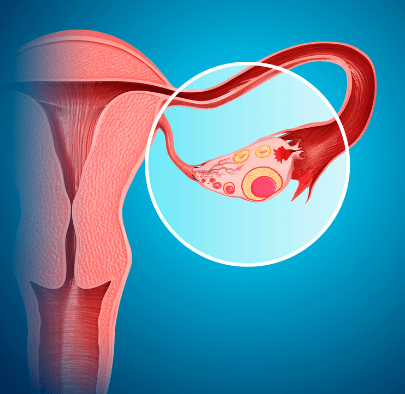Do you know when you’re going to ovulate? If you don’t, you can be losing out on essential data about your body and when is the best time to conceive. This article will go through the signs of ovulation and offer some advice on keeping track of your cycle.
Table of Contents
What is Ovulation?
 The ovary releases an egg, which travels down the fallopian tube to be fertilized by sperm. Ovulation is the process through which this happens. If the egg is not fertilized, it will disintegrate and be expelled with your uterine lining at the end of your cycle.
The ovary releases an egg, which travels down the fallopian tube to be fertilized by sperm. Ovulation is the process through which this happens. If the egg is not fertilized, it will disintegrate and be expelled with your uterine lining at the end of your cycle.
When do you Ovulate?
You are most fertile during the days leading up to and including ovulation. Most women ovulate about 14 days before their next period, but this can vary from month to month and from woman to woman. Your ovulation may occur closer to the start of your period if you have a shorter cycle or closer to the end if you have a longer cycle.
How Long does Ovulation Last?
You are fertile for several days before and after ovulation, even if it only lasts a few days. Sperm can remain in the reproductive system for up to five days, and the egg can be fertilized for 12-24 hours following discharge.
Signs and Symptoms of Ovulation
Ovulation Pain (Mittelschmerz)
In many women, a tingling sensation in the lower abdomen on one side is one of the most typical indicators of ovulation. This pain is caused by the egg being released from the ovary and is often called “mittelschmerz,” which means “middle pain” in German. Mittelschmerz can range from mild discomfort to a sharp pain that lasts for a few minutes to a few hours.

Changes in Body Temperature
The temperature of your body raises a little when you’re ovulating. You may notice this yourself if you take your temperature every day with a basal body temperature (BBT) chart. Just before ovulation, there is a slight dip in your BBT, and then it rises the next day and stays elevated until you get your period.
Changes in Cervical Mucus
During ovulation, your cervical mucus may vary. There is a spike in the hormone estrogen just before ovulation, which causes your cervix to produce more mucus. This mucus is thin, watery, and stretchy, like raw egg whites. It helps to lubricate your vagina and makes it easier for sperm to travel to the egg. After ovulation, your estrogen levels drop, and your cervical mucus becomes thicker and less stretchy.
Changes in Saliva
Some women notice changes in their saliva during ovulation. These changes are caused by a rise in estrogen, which causes an increase in the production of mucus. This mucus makes your saliva appear wetter and more stringy.
Tender Breasts
Another frequent symptom of ovulation is breast tenderness, caused by a surge in estrogen levels and often subsides within a few days. Before your menstruation, you may experience a similar soreness.
Bloating
During ovulation, many women experience bloating or weight gain. When estrogen levels rise, your body is more likely to retain water. After a few days, the bloating should subside. You may also notice that your clothing is a little tighter than usual during this time of year.
How to Predict and Track Ovulation
If you are trying to get pregnant, it is crucial to know when you ovulate. There are a few different ways to predict and track ovulation:
➛ Use an ovulation predictor kit (OPK): These kits test your urine for the presence of the luteinizing hormone (LH), which surge just before ovulation.
➛ Check your cervical mucus: This method is often used by women trying to avoid pregnancy. You can check your cervical mucus by wiping your vagina with toilet paper or a piece of cloth. If it is stretchy and clear, it means you are ovulating.
➛ Check your basal body temperature (BBT): Your BBT is your body temperature when you are at rest, and it rises when you ovulate. You can track your BBT with a special thermometer or a fertility tracker app.
➛ Use an ovulation calculator: This tool uses the average length of your menstrual cycle to predict when you will ovulate.
Ovulation Home Tests
Ovulation Tests
These are similar to pregnancy tests in that they both test for the presence of hormones in your urine. However, ovulation tests look for the hormone LH, while pregnancy tests look for the hormone hCG.
Ovulation tests are available as strips or digital devices. To use an ovulation strip, you will need to urinate on the strip and then wait a few minutes for the results. Digital ovulation tests will give you a positive or negative result on a screen.
Ovulation Predictors
Ovulation predictors are similar to ovulation tests, but they are more accurate. They can also be used as home fertility monitors. They test your urine for the presence of LH. They usually come with a digital device that will give you a positive or negative result on a screen.
To use an ovulation predictor, you will need to urinate on the test strip and then wait a few minutes for the results.
BBT Monitors
A BBT monitor is a device that tracks your basal body temperature. Your BBT rises when you ovulate. To use a BBT monitor, you will need to take your temperature every morning before getting out of bed. You can then track your BBT using a fertility tracker app or a special thermometer.
Saliva Tests
Saliva tests work by checking your saliva for the presence of estrogen, and this hormone increases during ovulation. To use a saliva test, you will need to collect a saliva sample and then wait a few minutes for the results.

Fertility Kits
Fertility kits are tools that help you track your ovulation. They usually come with a digital device, test strips, and instructions. To use a fertility kit, you will need to collect a urine sample and then wait a few minutes for the results.
Signs of Irregular Ovulation
Irregular or Missing Periods
The most common sign of irregular ovulation is a missing period, and this can be caused by several things, including stress, weight loss, or polycystic ovarian syndrome (PCOS). You will notice that your periods are irregular if they come less often than every 21 days or more often than every 35 days.
No Rise in Basal Body Temperature
If you track your basal body temperature, you will notice that it does not rise during ovulation, which is a sign of irregular ovulation. You can track your BBT with a special thermometer or a fertility tracker app. You will take your temperature every morning before getting out of bed with this method.
Inconsistencies in Ovulation Test Results
If you are using an ovulation test, you may notice that your results are inconsistent, which is a sign of irregular ovulation. You should use an ovulation test designed to be used as a home fertility monitor, and these tests are more accurate than regular ovulation tests.
Final Thought Signs of Ovulation
Ovulation is essential for conception, but it doesn’t always happen like clockwork. If you’re trying to get pregnant, it’s necessary to be aware of the signs of ovulation. By tracking your basal body temperature, using an ovulation test, or monitoring your cervical mucus, you can better predict when you ovulate.
And if you’re not ovulating regularly, there are fertility treatments that can help. So don’t despair if you’re not getting pregnant right away. With a bit of time and patience, you will soon be able to establish a family of your own!

